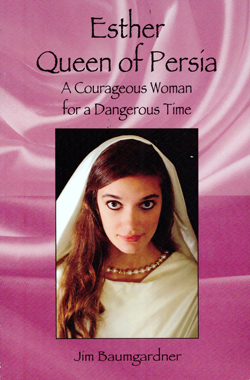Jim Baumgardner, Esther Queen of Persia: A Courageous Woman for a Dangerous Time, Wichita, Kansas: Baumgardner Press, 2013, ISBN 978-0-9884107-1-8, 293 pages, $16.95, www.biblenovels.net
By Donald H. Harrison


SAN DIEGO — For centuries rabbis have been providing supplemental information to that found in Jewish Scriptures. You might think of Esther Queen of Persia as such a midrash, except for the fact that author Baumgardner is not a rabbi. He is a Christian author, whose writings show a deep knowledge and respect for Jewish people.
Of course, there will be those among us Jews who will take exception to Baumgardner calling God by the name that many assume is the correct pronunciation of the Hebrew four letter combination yud-hay-vav-hay. I’ll confess the use of the word makes me squeamish, even though I have heard rabbis affirm that the way Baumgardner and others pronounce it cannot really be the sacred name of God. Who can really know, except the High Priest who, it is said, would go into the Holy of Holies on Yom Kippur and quietly pronounce the name so that no others would hear?
The rest of us, including Baumgardner, can only guess what that name was. Nevertheless, I and many other Jews prefer to use a circumlocution like “HaShem,” (The Name) or even, simply, “God” rather than taking any chances on being too familiar My guess, in contrast to Baumgardner’s, is that Queen Esther also might have been circumspect in how she referred to the Almighty.
So, if use of a name of God, even if it is a mispronunciation, might offend you, don’t read Baumgardner’s book. But for the rest of us, I’d have to say that this fictional account of Queen Esther’s life is a very thoughtful story. It is categorized as a Young Adult Book, meaning that it is intended for teenagers. For this reason, and also because Baumgardner is writing as a self-identified Christian author, there are no lurid passages about Vashti, who was King Ahasuerus’s first wife, nor about Esther (born Hadassah) on the night that she was summoned to the king’s bed chamber.
Readers are told that Vashti refused to dance naked before the king and the nobles he was entertaining–a command that Baumgardner suggests was issued by Ahasuerus because drunkenness and his desire to impress the nobles clouded his good judgment. Later Ahausuerus regretted banishing Vashti, but once the king formally issues an edict, it cannot be changed–not even by the king himself.
In Baumgardner’s story, Hadassah and other beautiful virgins are commanded to live in the king’s compound for a year before they will be presented to the king for possible selection as a queen. During that year, Hadassah’s name was changed to Esther, she was given servants to attend to her every need, and received lessons on royal protocol and prerogatives. Instead of becoming spoiled, or haughty, as some of the other girls did, Hadassah remained polite, respectful and thoughtful. She embodied the combination that Ahasuerus was looking for — someone who could sit beside him on the throne, with whom he could converse intelligently and to whom he could confide.
As Baumgardner imagined it, Esther was scandalized by the way that the king had treated Vashti, but she wisely kept her counsel. Nor was she at all pleased that she would be required to have sexual relations with the king before he decided whether she would be the queen, but she reasoned that this was the way of the world. Hadn’t King Solomon had a thousand wives and concubines, and hadn’t King David before seduced more than one woman, and even Bathsheba, the wife of another?
The author further imagined that notwithstanding his voracious appetite for new bed partners, Ahasuerus was a gentle lover, who was kind as he initiated Esther into womanhood. As in an old fashioned movie, we watched as Ahasuerus kissed Esther, and noted that Esther felt herself responding. As to what followed next was left to our imagination. Were it a movie, this book definitely would have been rated PG, not R.
Baumgardner remains faithful to the plot points that are covered in the Megillah, which is yearly read in synagogues to the accompaniment of much booing and hissing whenever the name of Haman is mentioned.
Haman’s hatred for the Jews is explained in Baumgardner’s book as stemming from the fact that Esther’s cousin, Mordecai, was a descendant of King Saul, whereas Haman’s ancestor was King Agag, an Amalekite whose army was defeated by King Saul’s. The hatred between the two peoples and families continued unabated through the centuries.
Baumgardner makes good use in his novel of biblical analogy. Hadn’t God raised up a Hebrew boy, Joseph, to become the second most powerful man in Egypt next to Pharaoh? Hadn’t Moses been plucked from a basket in the river to become an important prince of Egypt? And hadn’t a poor shepherd boy, David, been made king over all the Jewish people? So, Esther and Mordecai pondered, was it not also possible that God had arranged for Esther to become queen so that she too could do her people some important service?
*
Harrison is editor of San Diego Jewish World. He may be contacted at donald.harrison@sdjewishworld.com
Pingback: Filling in the blanks in the Book of Ruth - San Diego Jewish World